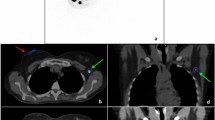Abstract
The recently introduced technique of sentinel lymph node dissection (SLND) may replace complete axillary lymph node dissection for axillary staging of early breast cancer. Successful SLND is predicated on meticulous delineation of the lymphatic pathway and sentinel node(s). Currently employed lymphatic mapping materials include vital blue dyes and radioactive tracers. Techniques of intraoperative lymphatic mapping and SLND using dye, tracer, or both have high success rates in the hands of experienced investigators, but their routine and widespread use awaits resolution of questions about the timing, dose, and type of radioactive tracer; the optimal lymphatic mapping technique; indications and contraindications for SLND; and certification of qualified surgeons, pathologists, and nuclear medicine physicians.
Similar content being viewed by others
Author information
Authors and Affiliations
Additional information
14 May 2001
Rights and permissions
About this article
Cite this article
Hsueh, E., Turner, R. & Giuliano, A. Lymphoscintigraphy and Lymphatic Mapping for Identification of Sentinel Lymph Nodes. World J. Surg. 25, 794–797 (2001). https://doi.org/10.1007/s00268-001-0007-6
Published:
Issue Date:
DOI: https://doi.org/10.1007/s00268-001-0007-6




